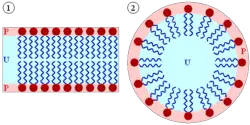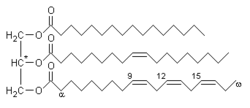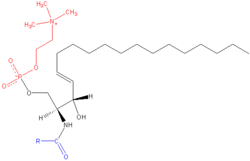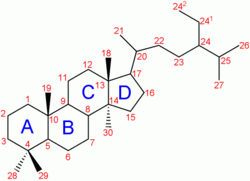Lipid
Along with proteins, nucleic acids and carbohydrates, lipids are one of the major classes of biologically important molecules or biomolecules. They are water-insoluble organic compounds that are highly soluble in nonpolar organic solvents.
Although the term lipid is often used informally as a synonym for fat, the latter is in fact a subgroup of lipids referred to as a triglyceride. Unlike other groups of molecules, lipids comprise a broad and diverse range of structures, which also include phospholipids (components of cell membranes), sterols (most notably cholesterol and the steroid hormones), and more complex lipid derivatives such as glycolipids (sugar-linked lipids).
Consistent with their diverse chemical and structural properties, lipids have a variety of functions in the body:
- Structuring cell membranes. The cell membrane constitutes a barrier for the cell and controls the flow of material in and out of the cell
- Energy storage. Triglycerides are an efficient form of energy storage that can be mobilized
- Signal transduction, or the transmission of information in cells. Lipid hormones like steroids and eicosanoids also mediate communication between cells.
- Lipid vitamins are required for metabolism, usually as coenzymes.
Lipids play diverse and important roles in nutrition and health. Many lipids are absolutely essential for life. However, there is also considerable awareness that abnormal levels of certain lipids, particularly cholesterol (in hypercholesterolemia) and, more recently, trans fatty acids, are risk factors for heart disease and other diseases.
The major classes of lipids and their properties
The term lipid is really a catch-all phrase for a wide variety of hydrocarbon-based molecules of biological origin. Lipids encompass a huge range of structures, which can be aliphatic or aromatic, acyclic or cyclic, straight or branched, saturated or unsaturated, flexible or rigid. This diversity makes it impossible to define lipids on the basis of a single core structural feature or biosynthetic origin.
However, one shared property of many lipids is that they are amphipathic (or amphiphilic) molecules. Although lipids are predominantly nonpolar or hydrophobic ("water-fearing"), meaning that they do not interact well with polar solvents like water, most lipids also have some polar or hydrophilic ("water-loving") component. In the case of cholesterol, the polar group is a mere -OH (hydroxyl or alcohol). In the case of the membrane lipids called phospholipids, the polar groups are considerably larger and more polar.
This amphipathic character of many lipids, particularly the subgroup of phospholipids, directly influences their function in the body, by allowing them to spontaneously organize into cellular or intracellular compartments in water. Within the aqueous environment of the body, the polar heads of lipids tend to orient outward to interact with external water molecules, while the hydrophobic tails tend to minimize their contact with water. The nonpolar tails of lipids cluster together internally, forming a small sphere called a micelle, in the case of single-tailed amphipathic lipids. Two-tailed phospholipids instead form lipid bilayers, which can be considerably larger than micelles, and form a hollow sphere that encloses a separate aqueous compartment. These bilayers are the structural components of the biological membranes that form the biological membranes of cells as well as intracellular compartments called organelles.
The basic classes of lipids are as follows:
- Fatty acids: a type of carboxylic acid (an organic acid with terminal carboxyl group [-COOH]) that is a component of many other classes of lipids.
- Glycerides (or glycerolipids): structurally based on a glycerol backbone, these lipids include monoglycerides, diglycerides, and triglycerides as well as the phosphoglycerides (or glycerophospholipids) found in biological membranes.
- Nonglycerides: structurally based on a non-glycerol backbone, this category includes sphingolipids, [sterol]] lipids (such as cholesterol and the steroid hormones), prenol lipids (such as terpenoids), waxes, and polyketides.
- More complex lipid derivatives, such as sugar-linked lipids (glycolipids) and protein-linked lipids.
An alternative classification system has been proposed (J. Lipid Res. 46:839), which instead divides lipids into the following groups: (1) fatty acyls, (2) glycerolipids, (3) glycerophospholipids, (4) sphingolipids, (5) sterol lipids, (6) prenol lipids, (7) saccharolipids and (8) polyketides.
Fatty acids: the building blocks of lipids
Fatty acids can be described as a class of compounds containing a long hydrocarbon chain and a terminal carboxylate group. They have a general structure of CH3(CH2)nCOOH. The chain usually ranges from 14 to 24 carbons in length, and typically contains an even number of carbons. Fatty acids can be either saturated or unsaturated:
- Saturated fatty acids have no double bonds between the carbon atoms of the fatty acid chain (hence, they are fully saturated with hydrogen atoms).
- Fatty acids with one or more double bonds are known as unsaturated fatty acids. The presence of double bonds generally reduces the melting point of fatty acids. Short chain length and unsaturation thus enhances the fluidity of fatty acids and their derivatives.
Unsaturated fatty acids can occur either in cis or trans geometric isomers. In most naturally occurring fatty acids, the double bonds are in the cis configuration. However, trans bonds are characteristically produced during the industrial hydrogenation of plant oils. Research suggests that, for reasons not yet well understood, increasing amounts of trans fats areo correlate with circulatory diseases such as atherosclerosis and coronary heart disease.
When they are not attached to other molecules, they are known as "free" fatty acids. Free fatty acids may come from the breakdown of a triglyceride into its components (fatty acids and glycerol). Free fatty acids are an important source of fuel for many tissues since they can yield relatively large quantities of ATP. Although many cell types can use either glucose or fatty acids for fuel, heart and skeletal muscle prefer fatty acids. On the other hand, the brain cannot use fatty acids as a source of fuel, relying instead on glucose, or on ketone bodies produced by the liver from fatty acid metabolism during starvation, or periods of low carbohydrate intake.
Glycerides: the energy storage lipids
Glycerides have a glycerol core structure and one or more fatty acyl groups, which are fatty acid-derived chains attached to the glycerol backbone by ester linkages. Glycerides with three acyl groups (triglycerides or neutral fats) are the main storage form of fat in animals and plants. Triglycerides (which are also known as triacylglycerols or triacylglycerides) are stored in specialized cells called adipocytes, which compose the adipose tissue that cushions and insulates the body.
Triglycerides play an important role in metabolism as energy sources. They contain more than twice as much energy (9 kcal/g) as carbohydrates and proteins. Triglycerides were evolutionarily selected as the primary form of energy storage because their chemical properties make them a concentrated and efficient solution; they are reduced and anhydrous, as opposed to the more polar carbohydrates, which need to be stored with water.
Phospholipids: membrane components
Another important group of glycerides are the phospholipids, which are the major constituents of biological membranes, such as the cell's plasma membrane and the intracellular membranes of organelles. Phospholipids are a class of lipids formed from four components: fatty acids, a negatively-charged phosphate group, nitrogen containing alcohol and a backbone. Phospholipids with a glycerol backbone are known as glycerophospholipids or phosphoglycerides. There is only one type of phospholipid with a sphingosine backbone; sphingomyelin. In particular, phosphoglycerides or glycerophospholipids contain a glycerol core linked to two fatty acid-derived tails by ester and to one "head" group by a phosphate ester linkage.
These phospholipids are subject to a variety of reactions in the cell: for instance, polar head groups or fatty acid tails can be released from specific phospholipids through enzyme-catalyze hydrolysis to generate second messengers involved in signal transduction. In the case of phosphatidylinositol, the head group can be enzymatically modified by the addition of one to three phosphate molecules, and this constitutes another mechanism of cell signaling.
While phospholipids are the major component of biological membranes, other non-glyceride lipid components like sphingolipids and sterols (such as cholesterol in animal cell membranes) are also found in biological membranes.
Sterol lipids: structure and signaling
add text
Cholesterol
Cholesterol is a sterol (a combination steroid and alcohol) and a lipid found in the cell membranes of all body tissues, and transported in the blood plasma of all animals. Lesser amounts of cholesterol are also found in plant membranes. The name originates from the Greek chole- (bile) and stereos (solid), and the chemical suffix -ol for an alcohol, as researchers first identified cholesterol (C27H45OH) in solid form in gallstones in 1784.
Most cholesterol is not dietary in origin; it is synthesized internally. Cholesterol is present in higher concentrations in tissues which either produce more or have more densely-packed membranes, for example, the liver, spinal cord and brain, and also in atheromata. Cholesterol plays a central role in many biochemical processes, but is best known for the association of cardiovascular disease with various lipoprotein cholesterol transport patterns and high levels of cholesterol in the blood.
When doctors talk to their patients about the health concerns of cholesterol, they are often referring to "bad cholesterol", or low-density lipoprotein (LDL). "Good cholesterol" is high-density lipoprotein (HDL); this denotes the way cholesterol is bound in lipoproteins, the natural carrier molecules of the body.
Cholesterol is required to build and maintain cell membranes; it makes the membrane's fluidity - degree of viscosity - stable over wider temperature intervals (the hydroxyl group on cholesterol interacts with the phosphate head of the membrane, and the bulky steroid and the hydrocarbon chain is embedded in the membrane). Some research indicates that cholesterol may act as an antioxidant.[1] Cholesterol also aids in the manufacture of bile (which helps digest fats), and is also important for the metabolism of fat soluble vitamins, including vitamins A, D, E and K. It is the major precursor for the synthesis of vitamin D, of the various steroid hormones, including cortisol and aldosterone in the adrenal glands, and of the sex hormones progesterone, estrogen, and testosterone. Further recent researchTemplate:Citationneeded shows that cholesterol has an important role for the brain synapses as well as in the immune system, including protecting against cancer.
Steroid hormones
A steroid is a lipid characterized by a carbon skeleton with four fused rings. All steroids are derived from the acetyl CoA biosynthetic pathway. Different steroids vary in the functional groups attached to these rings. Hundreds of distinct steroids have been identified in plants, animals, and fungi. Their most important role in most living systems is as hormones. Steroid hormones produce their physiological effects by binding to steroid hormone receptor proteins. The binding of steroid hormones to their receptors causes changes in gene transcription and cell function.
In human physiology and medicine, the most important steroids are cholesterol, the steroid hormones, and their precursors and metabolites. In the bloodstream steroids are bound to carrier proteins.
Cholesterol is an important steroid alcohol, being a common component of animal cell membranes. However, a high level of it can cause various conditions and diseases, such as atherosclerosis. Most other steroids are synthesized from cholesterol. Also, various hormones, including vertebrate sex hormones, are steroids created from cholesterol.
Some of the common categories of steroids include:
- Anabolic steroids are a class of steroids that interact with androgen receptors to increase muscle and bone synthesis. There are natural and synthetic anabolic steroids. These are the "steroids" used by athletes to increase performance.
- Corticosteroids include glucocorticoid and mineralocorticoids:
- Glucocorticoids regulate many aspects of metabolism and immune function, and often prescribed by doctors to reduce inflammatory conditions like asthma and arthritis.
- Mineralocorticoids are corticosteroids that help maintain blood volume and control renal excretion of electrolytes.
- Sex steroids are a subset of sex hormones that produce sex differences or support reproduction. They include androgens, estrogens, and progestagens.
- Phytosterols - steroids naturally occurring in plants.
ReferencesISBN links support NWE through referral fees
- Stryer, Lubert. 1994. Biochemistry, 4th edition. New York, NY: W.H. Freeman.
External links
- ApolloLipids - Provides dyslipidemia and cardiovascular disease prevention and treatment information as well as continuing medical education programs.
- Lipids, Membranes and Vesicle Trafficking - The Virtual Library of Biochemistry and Cell Biology
- The Lipid library - provides information on the chemistry, analysis and biochemistry of lipids
- LIPID MAPS: LIPID Metabolites and Pathways Strategy
- IUPAC glossary entry for the lipid class of molecules what is IUPAC?
- "A comprehensive classification system for lipids"
- CCMDWeb, a lipid health educational resource on global risk reduction for dyslipidemia and cardiovascular disease as well as online CME programs.
Credits
New World Encyclopedia writers and editors rewrote and completed the Wikipedia article in accordance with New World Encyclopedia standards. This article abides by terms of the Creative Commons CC-by-sa 3.0 License (CC-by-sa), which may be used and disseminated with proper attribution. Credit is due under the terms of this license that can reference both the New World Encyclopedia contributors and the selfless volunteer contributors of the Wikimedia Foundation. To cite this article click here for a list of acceptable citing formats.The history of earlier contributions by wikipedians is accessible to researchers here:
The history of this article since it was imported to New World Encyclopedia:
Note: Some restrictions may apply to use of individual images which are separately licensed.
- ↑ Smith LL. Another cholesterol hypothesis: cholesterol as antioxidant. Free Radic Biol Med 1991;11:47-61. PMID 1937129.






